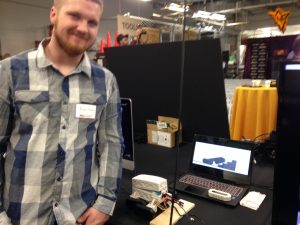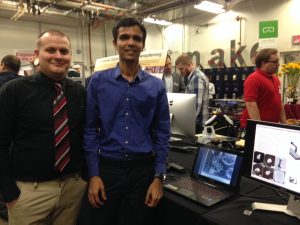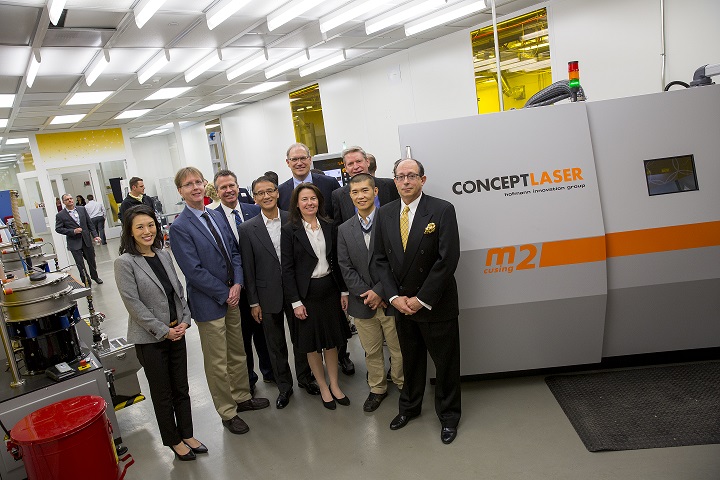Other than free pizza, nothing makes an engineering college student happier than cool new tools. And nothing makes industry happier than having those tools put to work solving real problems, especially in additive manufacturing (AM) or 3D printing.
 Jason Olson, ASU mechanical engineering master’s student, presenting his work on J-Bot, a Reconfigurable Autonomous Transport (RAT), prototyped with the aid of 3D printing. Image courtesy of Pamela Waterman.
Jason Olson, ASU mechanical engineering master’s student, presenting his work on J-Bot, a Reconfigurable Autonomous Transport (RAT), prototyped with the aid of 3D printing. Image courtesy of Pamela Waterman.Arizona State University—host to the largest engineering school in the U.S.—offers the only manufacturing engineering undergraduate degree in the state through its Polytechnic School. Located in the Phoenix suburb of Mesa, ASU Polytechnic just kicked things up a notch with the launch of the Southwest’s largest 3D printing research facility: the ASU Manufacturing Research and Innovation Hub.
A Hub for Interdisciplinary 3D Printing Solutions
The Hub’s 15,000 sq. ft. and $2 million in the latest plastic, polymer and metal 3D-printing equipment will allow students, faculty and industry partners to make real contributions to all facets of the AM field.Honeywell Aerospace, Concept Laser Inc., Phoenix Analysis & Design Technologies Inc. (PADT) and Stratasys Ltd. partnered with the ASU Fulton Schools to establish the Hub—purposely named to illustrate the coming together of participants and resources from many sources, to share ideas and develop interdisciplinary solutions.
Need to get a vehicle over rough terrain, e.g. rocky roads or earthquake debris? ASU mechanical engineering master’s student Jason Olson is working on a project called J-Bot, a Reconfigurable Autonomous Transport (RAT). The project’s objective is to develop a vehicle that can be reconfigured from tracked locomotion to “legged” locomotion. Olson 3D-printed the tank-like treads out of filament PLA for a scale model, producing a jointed, movable traction structure. The project is in its second round of prototyping. Plans for the J-Bot include printing more sophisticated, multi-material models with the Hub’s Stratasys Connex system.
Watch the J-Bot move over rocks and across a plain in the videos below.
ASU Ph.D. student Anagh Deshpande and senior undergraduate Lucas Casanova are working to prove the concept of an affordable industrial 3D printer for aluminum and other metals. They have printed dog bone test parts on the order of half-an-inch tall and are using these samples to investigate strength of materials in final parts. This study project is under the direction of ASU faculty member Dr. Keng Hsu, assistant professor, Manufacturing Engineering, ASU who is also advising students on such topics as electrochemical deposition and design for AM. These and other projects highlight how ASU Polytechnic students are gaining R&D experience on projects with real-world applicability.
 ASU Ph.D. student Anagh Deshpande and senior undergraduate Lucas Casanova are working to prove the concept of an affordable industrial 3D printer for aluminum and other metals. Image courtesy of Pamela Waterman.
ASU Ph.D. student Anagh Deshpande and senior undergraduate Lucas Casanova are working to prove the concept of an affordable industrial 3D printer for aluminum and other metals. Image courtesy of Pamela Waterman.Industry Partnerships Draw Upon Southwestern Expertise
Undergraduates, graduates, faculty and members of the sponsoring companies will get to work on a wide variety of top-notch equipment from test setups to scanning electron microscopes. With metal AM being a particularly hot industry topic, the lab is fortunate to host state-of-the art Concept Laser MLab and M2 LaserCUSING (powder-bed laser melting) metal systems. John Murray, president of Texas-based Concept Laser US, noted that his company’s acquisition by GE demonstrates AM’s high visibility even in large, traditional areas of manufacturing.Industrial partner Honeywell Aerospace sees this joint facility as a way to outsource research and development projects that can’t currently be staffed in-house.“We want to use the ASU lab to engage students to help us understand the science behind some of the things we’re doing, drawing young, brilliant minds into this exciting new field,” says Donald Godfrey, Honeywell engineering fellow for additive manufacturing.
ASU’s undergraduate and graduate programs have a long history of doing just this. Rey Chu, one of PADT’s principals and founders, is an ASU grad who started working withStereolithography (SLA) systems in the late ‘80s; he sees definite industry benefits from industry/educational collaborations. Eric Miller, another principal at PADT, noted that as more industries use AM to produce everything from dental work to tools and engine parts, even more students will need to know how to use these machines to move AM forward. PADT recently won a $281K federal grant to develop a software model that tests the viability of 3D printed parts under different stress conditions.
The whole point of the facility is to spark curiosity, said Malcom Green, associate director of corporate engagement with ASU’s Ira A. Fulton Schools of Engineering, and a former engineering director at Honeywell. “This maker space is a way for students to work with their hands,” he explains. “Students take design classes to receive a good introduction on additive manufacturing.”
 ASU PolyTech Manufacturing Research & Innovation Hub Opening Day attendees. Front row: Joyce Yeung, director of Marketing, Concept Laser; Kyle Squires, dean, Ira A. Fulton Schools of Engineering, ASU; Rey Chu, principal, Manufacturing Technologies, PADT Inc.; Ann McKenna, director, The Polytechnic School, Ira A. Fulton Schools of Engineering, ASU; Keng Hsu, assistant professor, The Polytechnic School, Ira A. Fulton Schools of Engineering, ASU; Donald Godfrey, engineering fellow, Honeywell Aerospace. Back row: John Murray, president and CEO, Concept Laser Inc.; Malcolm Green, associate director, Business & Industry Relations, Ira A. Fulton Schools of Engineering, ASU; Rich Barlow, vice president, Advanced Manufacturing Engineering, Honeywell Aerospace. Image courtesy of Jessica Hochreiter/ASU.
ASU PolyTech Manufacturing Research & Innovation Hub Opening Day attendees. Front row: Joyce Yeung, director of Marketing, Concept Laser; Kyle Squires, dean, Ira A. Fulton Schools of Engineering, ASU; Rey Chu, principal, Manufacturing Technologies, PADT Inc.; Ann McKenna, director, The Polytechnic School, Ira A. Fulton Schools of Engineering, ASU; Keng Hsu, assistant professor, The Polytechnic School, Ira A. Fulton Schools of Engineering, ASU; Donald Godfrey, engineering fellow, Honeywell Aerospace. Back row: John Murray, president and CEO, Concept Laser Inc.; Malcolm Green, associate director, Business & Industry Relations, Ira A. Fulton Schools of Engineering, ASU; Rich Barlow, vice president, Advanced Manufacturing Engineering, Honeywell Aerospace. Image courtesy of Jessica Hochreiter/ASU.About the Author
Follow Robotics 24/7 on Linkedin
Article topics
Email Sign Up
















